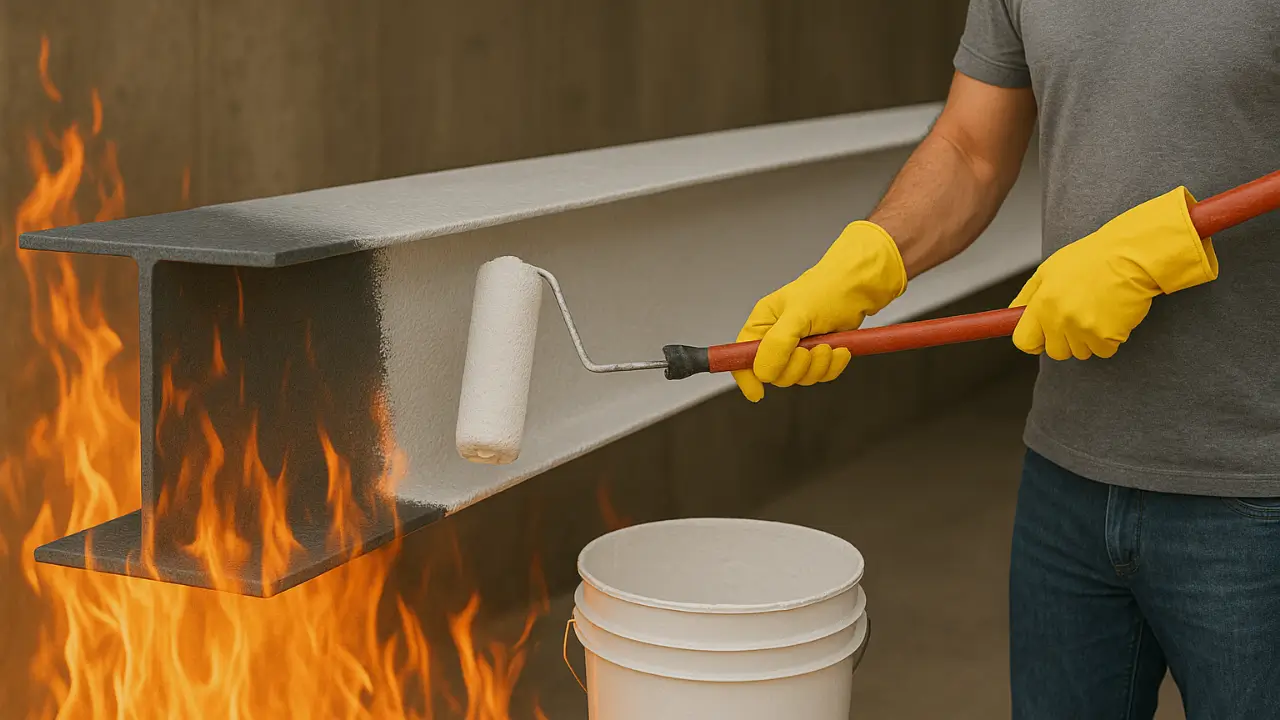
Every year, hundreds of thousands of fires occur worldwide, leading not only to substantial property damage but also to irreversible loss of life. In the field of fire safety, every precaution taken can be the difference between survival and catastrophe. While architectural design, fire suppression systems, and evacuation route planning are all critical, one often-overlooked element plays a pivotal role in life safety: intumescent paint.
What Is Intumescent Paint?
Intumescent paint—commonly referred to as fire-resistant or fire-retardant coating—is a specialized protective layer designed to insulate structural elements during a fire. At ambient temperatures, it appears no different from standard paint. However, when exposed to extreme heat, it undergoes a chemical reaction that causes it to expand and form a thick, carbonaceous char layer. This foam-like barrier protects the underlying material from high temperatures and delays heat transfer.
Used primarily on structural steel, concrete, ceilings, and walls, intumescent coatings are a critical component of passive fire protection systems. By preventing flame spread and insulating surfaces against heat, these coatings buy crucial time—slowing down the structural failure of the building and allowing occupants to evacuate safely.
Structural Stability in the First Minutes of a Fire
One of the greatest risks in the initial phase of a fire is structural collapse. Steel structures, in particular, begin to lose their load-bearing capacity at temperatures as low as 500–600°C—a threshold that can be reached within minutes of ignition. Without adequate protection, beams and columns can rapidly fail, resulting in catastrophic collapse.
Intumescent paints help prevent this scenario by thermally insulating load-bearing elements. On steel, they delay heat penetration, allowing the structure to maintain integrity long enough for evacuation and emergency response. Just a few extra minutes can mean the difference between rescuing children, aiding the elderly, and facing tragedy.
Fire Is More Than Flames: Heat and Toxic Gases
Fires are not only dangerous because of visible flames. The radiant heat and release of toxic gases—such as carbon monoxide and carbon dioxide—pose equal or greater risks. Moreover, elevated temperatures can ignite flammable materials even without direct flame contact.
By insulating surfaces from heat, intumescent coatings help contain temperature rise in surrounding areas, preventing secondary ignitions. This helps control the spread of the fire, increases the effectiveness of firefighting efforts, and reduces the chance of flashover in adjacent spaces.
A Vital Requirement in Public and Industrial Buildings
In large-scale facilities like shopping malls, airports, hospitals, schools, and industrial complexes, evacuation time is critical. For this reason, most building codes mandate fire protection of steel structural systems in such environments. But beyond regulatory compliance, providing fire-resilient structures is a moral obligation.
In high-rise buildings, fires can spread vertically in minutes. If structural elements fail early in the fire, escape routes become unusable, rendering even the best evacuation plans ineffective. Intumescent coatings preserve the structural integrity of these escape routes, ensuring safe egress.
Safety Without Compromising Aesthetics
There’s a misconception that fire-rated materials are unsightly and only suitable for industrial use. Modern intumescent coatings defy this notion. They are available in a wide range of colors and finishes, making them compatible with interior and exterior architectural design.
This makes them ideal for projects that demand both aesthetic excellence and superior fire performance. Architects and designers no longer have to choose between form and function—intumescent paint provides both.
Key Considerations When Selecting a Fire-Resistant Coating
The most critical factor when choosing a fire-protective coating is its certified fire resistance rating. Verified test results from accredited laboratories (based on standards such as EN 13381 or ASTM E119) should confirm the duration for which the coating can shield structural elements from fire.
Depending on the application, water-based or solvent-based formulations may be appropriate. Water-based products are preferred for their lower environmental impact and ease of use in enclosed spaces. Regardless of the formulation, proper surface preparation, film thickness, drying time, and application technique are vital to achieving the desired performance.
Professional installation by trained applicators is essential to ensure compliance with safety standards and manufacturer specifications.
NO-FIRE PAINT PLUS by Dryfix: Setting a New Standard in Fire Safety
Dryfix’s NO-FIRE PAINT PLUS is engineered to meet the highest standards in passive fire protection. This single-component, water-based, air-drying intumescent coating provides superior environmental performance without compromising on safety.
Upon exposure to heat, it expands into a dense, insulating foam layer that protects structural steel and other critical substrates for up to 120 minutes. This extended fire resistance window allows for safe evacuation and helps prevent structural failure during fire emergencies.
Whether applied in commercial, public, or industrial settings, NO-FIRE PAINT PLUS offers a smart, high-performance solution for fire safety planning. With its eco-friendly formulation and outstanding intumescent behavior, it represents one of the most effective, proactive measures in fire protection available today.
